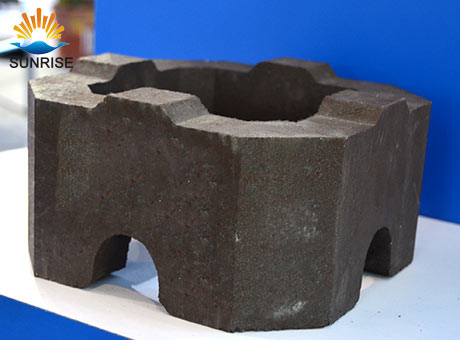Hot Product
Refractory Knowledge
Brief Analysis of The Performance and Use of Magnesia Bricks
Date:2019-09-10 14:51 From:Zhengzhou Sunrise Refractory Author:admin
It is well known that the refractoriness of magnesia bricks is as high as 2000 or more, and the load softening temperature varies greatly depending on the melting point of the binder phase and the liquid phase produced at high temperatures. Generally, the load-softening start temperature of magnesium bricks is between 1520 and 1600, while the high-purity magnesium has a heavy softening start temperature of up to 1800.
The starting temperature of the softening and softening of the magnesia bricks is not much different from the collapse temperature. This is because the main phase composition of the magnesia bricks is periclase, but the periclase crystals do not crystallize the network skeleton in the magnesia bricks, but are bonded by the conjugates. . In ordinary magnesia bricks, as a combination, it is generally a low-melting silicate phase such as calcium forsterite and magnesia, although the calcite crystals constituting the magnesia have a higher melting point, but melt at about 1500. The silicate phase exists, and its liquid phase has a small viscosity at high temperature. Therefore, it reflects that the load temperature of the ordinary magnesia brick is not much different from the collapse temperature, but it is quite different from the refractoriness. The high-purity magnesia bricks have a load softening start temperature of up to 1800, mainly because the combination of the magnesia grains is forsterite or dicalcium silicate, and the melting temperature of the eutectic formed by the MgO is high. The lattice strength between the crystals is large and the plastic deformation at high temperatures is small, and the crystal particles are well bonded.

The coefficient of linear expansion of magnesia bricks is generally 1.0% to 2.0% at 1000-1600, and is similar or linear. In refractory products, the thermal conductivity of magnesia bricks is second only to carbon-containing bricks, which decreases with increasing temperature. . Under the condition of 1100 water-cooling, the thermal shock of magnesia bricks is only 1 or 2 times. Magnesia bricks have strong resistance to CaO and ferrite alkaline slag, but have weak resistance to acidic slag such as SiO2.
Therefore, it cannot be directly contacted with silica bricks during use, and is generally separated by neutral bricks. At normal temperature, the conductivity of magnesia bricks is very low, but at high temperatures, its conductivity cannot be ignored. The performance of magnesia bricks is greatly different due to the different raw materials, production equipment and process measures.
Magnesia bricks are widely used in steelmaking furnace lining, iron alloy furnaces, mixed iron furnaces, non-ferrous metallurgical industrial furnaces, limestone kiln for building materials, and glass industrial regenerator lattices due to their high temperature performance and strong resistance to alkaline slag. High temperature calcining kiln and tunnel kiln for heat exchanger and refractory industry.
Inquiry:
If you have any questions or good suggestions on our products and site, or if you want to know more information about our products, please write them and send to us, a representative will contact you within one business day. We guarantee that your information will not be divulged to the third party.

